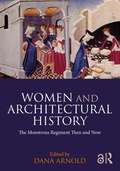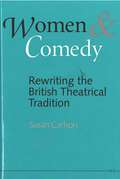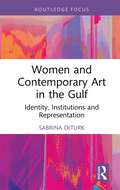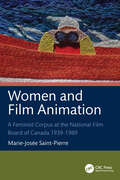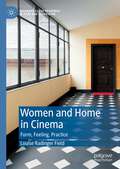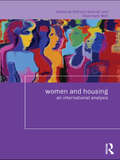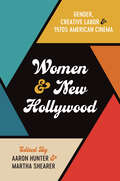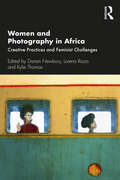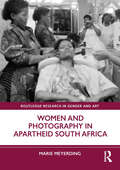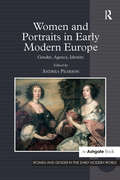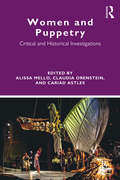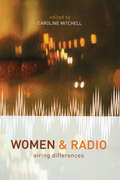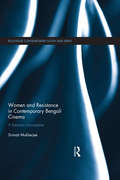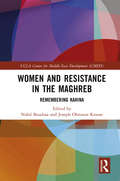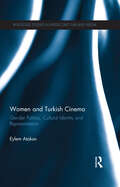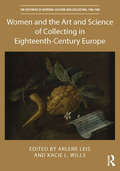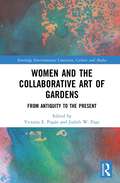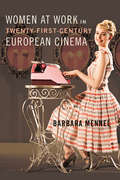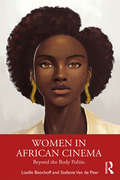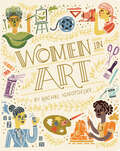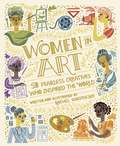- Table View
- List View
Women Writing and Directing in the USA: A Stage of Our Own
by Kiara PipinoWomen Writing and Directing in the USA: A Stage of Our Own features interviews with some of the most successful theatre artists currently working on and off Broadway and beyond. The book provides an insight on what it means and what it takes to be a successful female-identifying playwright and director in the USA, where the professional theatrical landscape is still mostly dominated by straight white men. The interviews explore a wide range of themes, including if and how the artists’ female perspective influenced their art, the social and cultural significance of their work, and how theatre and women working in theatre can participate in awakening greater social awareness. Readers will learn about some of the most current and relevant American theatre artists, such as Young Jean Lee, Pam MacKinnon, Dominique Morisseau, Rachel Chavkin, and Martyna Majok. Written for students in directing and playwriting courses, Women Writing and Directing in the USA: A Stage of Our Own features inspirational and informative stories that will help young theatre artists find and pursue their artistic voices.
Women and Architectural History: The Monstrous Regiment Then and Now
by Dana ArnoldIn this book, prominent architectural historians, who happen to be women, reflect on their practice and the intervention this has made in the discipline. Of particular concern are the ways in which feminine subjectivities have been embodied in the discourses of architectural history. Each of the chapters examines the author’s own position and the disruptive presence of women as both subject and object in the historiography of a specific field of enquiry. The aim is not to replace male lives with female lives, or to write women into the masculinist narratives of architectural history. Instead, this book aims to broaden the discourses of architectural history to explore how the potentially ‘unnatural rule’ of women subverts canonical norms through the empowerment of otherness rather than a process of perceived emasculation.The essays examine the historiographic and socio/cultural implications of the role of women in the narratives and writing of architectural history with particular reference to Western traditions of scholarship on the period 1600–1950. Rather than subscribing to a single position, individual voices critically engage with past and present canonical histories disclosing assumptions, biases, and absences in the architectural historiography of the West. This book is a crucial reflection upon historiographical practice, exploring potential openings that may contribute further transformation of the theory and methods of architectural history.Chapter 9 of this book is freely available as a downloadable Open Access PDF at http://www.taylorfrancis.com under a Creative Commons Attribution-NonCommercial-NoDerivatives (CC-BY-NC-ND) 4.0 International license.
Women and Comedy: Rewriting the British Theatrical Tradition
by Susan CarlsonThe first comprehensive study of its kind, this book explores the contradictory connections between women and dramatic comedy. Women and Comedy shows how a genre that has been used historically to restrict women's behavior is being reconfigured to express women's triumphs. It thus redefines the assumptions with which both traditional comedy and contemporary women's plays are read and viewed. Challenging a critical consensus that has seen comedy as a haven for female power, Carlson argues that traditional comedy is deeply sexist, welcoming strong women characters only because it can contain their power. Through an analysis of a range of comedies by Shakespeare, Congreve, Maugham, Shaw, and Ayckbourn, the author shows that even in these plays self-consciously about liberated females, women gain only a limited freedom, a freedom that the endings of the plays work to negate. This negotiation is seen to result in part from the comic structure itself, which privileges a merely temporary inversion and an ultimate return to the status quo. Carlson then examines the transitional work of three writers – Aphra Behn, Henry James, and Ann Jellicoe – whose heroines follow an unorthodox trajectory through their comic worlds. While the work of these writers clearly remains within the mainstream comic tradition, the author notes in them a subtle departure, most notably in their description of the heroine as subject rather than object, which prefigures the full-scale transformations of women in comedy by contemporary women writers. The book then examines contemporary comedy that revises traditional comic structure at the same time as it explores fundamental social change. In making her case for the difference of contemporary comedy by women, Carlson examines the reformulations of structure and character and considers issues of community, self, and sexuality in a broad range of plays by individual playwrights and by the new women's theater collectives. Women and Comedy is an important work for students of British drama and will appeal to theater practitioners, critics, feminist scholars, and all those interested in the performing arts.
Women and Contemporary Art in the Gulf: Identity, Institutions and Representation (Cultural Heritage, Art and Museums in the Middle East)
by Sabrina DeTurkWomen and Contemporary Art in the Gulf offers a unique focus on the roles of women in contemporary art, cultural production and arts institutions in the Gulf. Drawing on in-person experiences of the art and sites discussed, as well as research on regional artists and arts institutions, DeTurk argues that the Gulf Cooperation Council (GCC) countries of Bahrain, Kuwait, Oman, Qatar, Saudi Arabia and the United Arab Emirates have been largely excluded from the critical discourse about, and display of, contemporary Middle Eastern art. The book addresses this oversight by providing an examination of the work of several contemporary women artists from the Gulf region. DeTurk also discusses the role of women in museums and cultural institutions in the region, as well as the education systems available to emerging women artists. The discussion and analysis at the heart of the book connect to a range of larger themes, including the visual culture of patriarchy, connection to material culture and heritage, religious beliefs, trade and migration, rapid development, and the need to envision and create a post-oil economy. Women and Contemporary Art in the Gulf, with its examination of the critical role women play in the formation of the cultural landscape of the Gulf, is an important contribution to discourse around the changing role of the GCC. It will be essential reading for scholars and students engaged in the study of art history, visual culture, museums and heritage, and women and gender studies.
Women and Film Animation: A Feminist Corpus at the National Film Board of Canada 1939-1989
by Marie-Josée Saint-PierreThe creations of female animation filmmakers are recognized all over the world while being, paradoxically, unknown to the general public. Women and Film Animation: A Feminist Corpus at the National Film Board of Canada 1939-1989 brings out of the shadows the work of true pioneers by presenting and analyzing, from a resolutely feminist perspective, the works they have conceived within the National Film Board of Canada (NFB).This institution has played an essential role in the emergence of animated cinema in Canada, but it is forgotten or ignored that a good part of this vast corpus is the work of women who have worked there not only as assistants but also as directors. These artists have contributed to changing the traditional representations of women in a unique way in both commercial and avant-garde animated cinema. The author accounts for their concerns, their creativity, and their many bright achievements. To do this, she relies on a wide range of critical works in social and cultural history of Canada, in feminist art history, and on multiple studies on animated cinema.Key Features: Provides an interdisciplinary approach that combines concepts from feminist studies, film theory and visual arts for a nuanced analysis of the role of women in animated cinema Discusses historical and sociological background that sheds light on the condition of women Includes a profound analysis of the changes and continuities in the role of women in this industry over time, focusing on the National Film Board of Canada Features previously unreleased archival material and selected excerpts from reviews by the NFB’s programming committee, highlighting the impact of production circumstances of the works of specific women animators
Women and Home in Cinema: Form, Feeling, Practice (Palgrave Close Readings in Film and Television)
by Louise Radinger FieldThis book explores visions of home in cinema and the ways in which women inhabit the onscreen realm. Looking closely at a range of films made between 1936 and 2013, it examines how filmmakers reconfigure studio sets and real locations through the filmmaking process into mutable onscreen domains imbued with depth, metaphor, and expressivity.The book studies the films through the lens of four filmmaking processes in particular: découpage, mise-en-scène, sound and editing. Close analysis reveals how filmmakers use these cinematic ‘building blocks’ to shape onscreen worlds charged with emotion and animated by the warp and weft of psychic life.Images of home abound in the cinema, and women frequently find themselves at the core of both structures. Drawing on recent spatial and feminist enquiry, the book reviews the idea of home as a fixed and stable location and illustrates how the art of cinema is well equipped to explore home as an imaginary as well as a material realm.With its emphasis on film practice as a route into critical reflection, this book will be of interest to filmmakers, film theorists and those who simply want to understand more about how films work.
Women and Housing: An International Analysis (Housing and Society Series)
by Patricia KennettIn the context of contemporary economic, political, social and cultural transformations, this book brings together contributions from developed and emerging societies in Europe, the USA and East Asia in order to highlight the nature, extent and impact of these changes on the housing opportunities of women. The collection seeks to contribute to comparative housing debates by highlighting the gendered nature of housing processes, locating these processes within wider structured and institutionalized relations of power, and to show how these socially constructed relationships are culturally contingent, and manifest and transform over time and space. The international contributors draw on a wide range of empirical evidence relating to labour market participation, wealth distribution, family formation and education to demonstrate the complexity and gendered nature of the interlocking arenas of production, reproduction and consumption and the implications for the housing opportunities of women in different social contexts. Worldwide examples are drawn from Australia, China, Great Britain, Hong Kong, Japan, Spain, Sweden, Taiwan and the USA.
Women and New Hollywood: Gender, Creative Labor, and 1970s American Cinema
by James Morrison Amelie Hastie Karen Pearlman Oliver Gruner Nicholas Godfrey Anna Backman Rogers Maria Pramaggiore Maya Montañez Smukler Alicia Kozma Nicholas Forster Abigail Cheever Virginia Bonner Adrian GarveyThe 1970s has often been hailed as a great moment for American film, as a generation of “New Hollywood” directors like Scorsese, Coppola, and Altman offered idiosyncratic visions of what movies could be. Yet the auteurist discourse hailing these directors as the sole authors of their films has obscured the important creative roles women played in the 1970s American film industry. Women and New Hollywood revises our understanding of this important era in American film by examining the contributions that women made not only as directors, but also as screenwriters, editors, actors, producers, and critics. Including essays on film history, film texts, and the decade’s film theory and criticism, this collection showcases the rich and varied cinematic products of women’s creative labor, as well as the considerable barriers they faced. It considers both women working within and beyond the Hollywood film industry, reconceptualizing New Hollywood by bringing it into dialogue with other American cinemas of the 1970s. By valuing the many forms of creative labor involved in film production, this collection offers exciting alternatives to the auteurist model and new ways of appreciating the themes and aesthetics of 1970s American film.
Women and Photography in Africa: Creative Practices and Feminist Challenges
by Darren Newbury; Lorena Rizzo; Kylie ThomasThis collection explores women’s multifaceted historical and contemporary involvement in photography in Africa. The book offers new ways of thinking about the history of photography, exploring through case studies the complex and historically specific articulations of gender and photography on the continent, and attending to the challenge and potential of contemporary feminist and postcolonial engagements with the medium. The volume is organised in thematic sections that present the lives and work of historically significant yet overlooked women photographers, as well as the work of acclaimed contemporary African women photographers such as Héla Ammar, Fatoumata Diabaté, Lebohang Kganye and Zanele Muholi. The book offers critical reflections on the politics of gendered knowledge production and the production of racialised and gendered identities and alternative and subaltern subjectivities. Several chapters illuminate how contemporary African women photographers, collectors and curators are engaging with colonial photographic archives to contest stereotypical forms of representation and produce powerful counter-histories. Raising critical questions about race, gender and the history of photography, the collection provides a model for interdisciplinary feminist approaches for scholars and students of art history, visual studies and African history.
Women and Photography in Apartheid South Africa (Routledge Research in Gender and Art)
by Marie MeyerdingTracing the lives and works of five women in four case studies, author Marie Meyerding examines the representation of women in the field of photography in South Africa in the second half of the twentieth century. All of them are critically understudied, with no existing scholarship dedicated exclusively to their photographic contributions.Focusing on the representation of women on two different levels—as agents, behind the camera, and as subjects, in photographs—it showcases women photographers portraying their female contemporaries and analyses to what extent they adhered to or subverted common forms of gender representation. In recuperating their forgotten archives, the book argues that none of these women are marginal figures, but rather that each of them played a leading role in the field of photography in their own time.The book will be of interest to scholars working in art history, history of photography, gender studies, intersectionality and African studies.
Women and Portraits in Early Modern Europe: Gender, Agency, Identity (Women and Gender in the Early Modern World)
by Andrea PearsonAs one of the first books to treat portraits of early modern women as a discrete subject, this volume considers the possibilities and limits of agency and identity for women in history and, with particular attention to gender, as categories of analysis for women's images. Its nine original essays on Italy, the Low Countries, Germany, France, and England deepen the usefulness of these analytical tools for portraiture. Among the book's broad contributions: it dispels false assumptions about agency's possibilities and limits, showing how agency can be located outside of conventional understanding, and, conversely, how it can be stretched too far. It demonstrates that agency is compatible with relational gender analysis, especially when alternative agencies such as spectatorship are taken into account. It also makes evident the importance of aesthetics for the study of identity and agency. The individual essays reveal, among other things, how portraits broadened the traditional parameters of portraiture, explored transvestism and same-sex eroticism, appropriated aspects of male portraiture to claim those values for their sitters, and, as sites for gender negotiation, resistance, and debate, invoked considerable relational anxiety. Richly layered in method, the book offers an array of provocative insights into its subject.
Women and Puppetry: Critical and Historical Investigations
by Alissa Mello Claudia Orenstein Cariad AstlesWomen and Puppetry is the first publication dedicated to the study of women in the field of puppetry arts. It includes critical articles and personal accounts that interrogate specific historical moments, cultural contexts, and notions of "woman" on and off stage. Part I, "Critical Perspective," includes historical and contemporary analyses of women’s roles in society, gender anxiety revealed through the unmarked puppet body, and sexual expression within oppressive social contexts. Part II, "Local Contexts: Challenges and Transformations," investigates work of female practitioners within specific cultural contexts to illuminate how women are intervening in traditionally male spaces. Each chapter in Part II offers brief accounts of specific social histories, barriers, and gender biases that women have faced, and the opportunities afforded female creative leaders to appropriate, revive, and transform performance traditions. And in Part III, "Women Practitioners Speak," contemporary artists reflect on their experiences as female practitioners within the art of puppet theatre. Representing female writers and practitioners from across the globe, Women and Puppetry offers students and scholars a comprehensive interrogation of the challenges and opportunities that women face in this unique art form.
Women and Radio: Airing Differences
by Caroline MitchellCombining classic work on radio with innovative research, journalism and biography, Women and Radio offers a variety of approaches to understanding the position of women as producers, presenters and consumers as well as offering guidelines, advice and helpful information for women wanting to work in radio.Women and Radio examines the relationship between radio audiences, technologies and programming and reveals and explains the inequalities experienced by women working in the industry.
Women and Resistance in Contemporary Bengali Cinema: A Freedom Incomplete (Routledge Contemporary South Asia Series)
by Srimati MukherjeeHistorically, Indian cinema has positioned women at the intersection of tradition and a more evolving culture, portraying contradictory attitudes which affect women’s roles in public and private spheres. Examining the work of three directors from West Bengal, this book addresses the juxtaposition of tradition and culture regarding women in Bengali cinema. It argues the antithesis of women’s roles, particularly in terms of ideas of resistance, revolution, change, and autonomy, by suggesting they convey resistance to hegemonic structures, encouraging a re-envisioning of women’s positions within the familial-social matrix. Along with presenting a perception of culture as dynamic and evolving, the book discusses how some directors show that with this rupturing of the traditionally prohibitive, and a notion of unmaking and making in women, a traditional inclination is exposed to align women with ideas of absence, substitution, and disposability. The author goes on to show how selected auteurs in contemporary Bengali cinema break with certain traditional representations of women, gesturing towards a culture that is more liberating for women. Presenting the first full-length study of women’s changing roles over the last twenty years of Bengali cinema, this book will be a useful contribution for students and scholars of South Asian Culture, Film Studies and Gender Studies.
Women and Resistance in the Maghreb: Remembering Kahina (UCLA Center for Middle East Development (CMED))
by Nabil BoudraaThis book studies women’s resistance in the three countries of the Maghreb, concentrating on two questions: First, what has been the role of women artists since the 1960s in unlocking traditions and emancipating women on their own terms? Second, why have Maghrebi women rarely been given the right to be heard since Algeria, Morocco, and Tunisia gained national independence? Honouring the artistic voices of women that have been largely eclipsed from both popular culture and political discourse in the Maghreb, the work specifically examines resistance by women since 1960s in the Maghreb through cinema, politics, and the arts. In an ancillary way, the volume addresses a wide range of questions that are specific to Maghrebi women related to upbringing, sexuality, marriage, education, representation, exclusion, and historical memory. These issues, in their broadest dimensions, opened the gates to responses in different fields in both the humanities and the social sciences. The research presents scholarship by not only leading scholars in Francophone studies, cultural history, and specialists in women studies, but also some of the most important film critics and practicing feminist advocates. The variety of periods and disciplines in this collection allow for a coherent and general understanding of Maghrebi societies since decolonization. The volume is a key resource to students and scholars interested in women’s studies, the Maghreb, and Middle East studies.
Women and Shakespeare in the Eighteenth Century
by Fiona RitchieFiona Ritchie analyses the significant role played by women in the construction of Shakespeare's reputation which took place in the eighteenth century. The period's perception of Shakespeare as unlearned allowed many women to identify with him and in doing so they seized an opportunity to enter public life by writing about and performing his works. Actresses (such as Hannah Pritchard, Kitty Clive, Susannah Cibber, Dorothy Jordan and Sarah Siddons), female playgoers (including the Shakespeare Ladies Club) and women critics (like Charlotte Lennox, Elizabeth Montagu, Elizabeth Griffith and Elizabeth Inchbald), had a profound effect on Shakespeare's reception. Interdisciplinary in approach and employing a broad range of sources, this book's analysis of criticism, performance and audience response shows that in constructing Shakespeare's significance for themselves and for society, women were instrumental in the establishment of Shakespeare at the forefront of English literature, theatre, culture and society in the eighteenth century and beyond.
Women and Turkish Cinema: Gender Politics, Cultural Identity and Representation (Routledge Studies in Middle East Film and Media)
by Eylem AtakavSince 2000, there has been a considerable effort in Turkish cinema to come to terms with the military’s intervention in politics and subsequent national trauma. It has resulted in an outpouring of cinematic texts. This book focuses on women and Turkish cinema in the context of gender politics, cultural identity and representation. The central proposition of this book is that enforced depolticisation introduced after the coup is responsible for uniting feminism and film in 1980s Turkey. The feminist movement was able to flourish precisely because it was not perceived as political or politically significant. In a parallel move in the films of the 1980s there was an increased tendency to focus on the individual, on women’s issues and lives, in order to avoid the overtly political. Women and Turkish Cinema provides a comprehensive view of cinema’s approach to women in a country which straddles European and Middle Eastern cultural conceptions, identities and religious values and will be an invaluable resource for students and scholars of Film Studies, Gender Studies and Middle East Studies, amongst others.
Women and the Art and Science of Collecting in Eighteenth-Century Europe (The Histories of Material Culture and Collecting, 1700-1950)
by Arlene Leis Kacie L. WillsThrough both longer essays and shorter case studies, this book examines the relationship of European women from various countries and backgrounds to collecting, in order to explore the social practices and material and visual cultures of collecting in eighteenth-century Europe. It recovers their lives and examines their interests, their methodologies, and their collections and objects—some of which have rarely been studied before. The book also considers women’s role as producers, that is, creators of objects that were collected. Detailed examination of the artefacts—both visually, and in relation to their historical contexts—exposes new ways of thinking about collecting in relation to the arts and sciences in eighteenth-century Europe. The book is interdisciplinary in its makeup and brings together scholars from a wide range of fields. It will be of interest to those working in art history, material and visual culture, history of collecting, history of science, literary studies, women’s studies, gender studies, and art conservation.
Women and the Art and Science of Collecting in Eighteenth-Century Europe (The Histories of Material Culture and Collecting, 1700-1950)
by Arlene Leis Kacie L. WillsThrough both longer essays and shorter case studies, this book examines the relationship of European women from various countries and backgrounds to collecting, in order to explore the social practices and material and visual cultures of collecting in eighteenth-century Europe.It recovers their lives and examines their interests, their methodologies, and their collections and objects—some of which have rarely been studied before. The book also considers women’s role as producers, that is, creators of objects that were collected. Detailed examination of the artefacts—both visually, and in relation to their historical contexts—exposes new ways of thinking about collecting in relation to the arts and sciences in eighteenth-century Europe. The book is interdisciplinary in its makeup and brings together scholars from a wide range of fields.It will be of interest to those working in art history, material and visual culture, history of collecting, history of science, literary studies, women’s studies, gender studies, and art conservation.
Women and the Collaborative Art of Gardens: From Antiquity to the Present (Routledge Environmental Literature, Culture and Media)
by Victoria E. Pagán Judith W. PageWomen and the Collaborative Art of Gardens explores the garden and its agency in the history of the built and natural environments, as evidenced in landscape architecture, literature, art, archaeology, history, photography, and film. Throughout the book, each chapter centers the act of collaboration, from garden clubs of the early twentieth century as powerful models of women’s leadership, to the more intimate partnerships between family members, to the delicate relationship between artist and subject. Women emerge in every chapter, whether as gardeners, designers, owners, writers, illustrators, photographers, filmmakers, or subjects, but the contributors to this dynamic collection unseat common assumptions about the role of women in gardens to make manifest the significant ways in which women write themselves into the accounts of garden design, practice, and history. The book reveals the power of gardens to shape human existence, even as humans shape gardens and their representations in a variety of media, including brilliantly illuminated manuscripts, intricately carved architectural spaces, wall paintings, black and white photographs, and wood cuts. Ultimately, the volume reveals that gardens are best apprehended when understood as products of collaboration. The book will be of interest to scholars and students of gardens and culture, ancient Rome, art history, British literature, medieval France, film studies, women’s studies, photography, African American Studies, and landscape architecture.
Women at Work in Twenty-First-Century European Cinema
by Barbara MennelFrom hairdressers and caregivers to reproductive workers and power-suited executives, images of women's labor have powered a fascinating new movement within twenty-first century European cinema. Social realist dramas capture precarious working conditions. Comedies exaggerate the habits of the global managerial class. Stories from countries battered by the global financial crisis emphasize the patriarchal family, debt, and unemployment. Barbara Mennel delves into the ways these films about female labor capture the tension between feminist advances and their appropriation by capitalism in a time of ongoing transformation. Looking at independent and genre films from a cross-section of European nations, Mennel sees a focus on economics and work adapted to the continent's varied kinds of capitalism and influenced by concepts in second-wave feminism. More than ever, narratives of work put female characters front and center--and female directors behind the camera. Yet her analysis shows that each film remains a complex mix of progressive and retrogressive dynamics as it addresses the changing nature of work in Europe.
Women from the Ankle Down: The Story of Shoes and How They Define Us
by Rachelle BergsteinRachelle Bergstein brings readers along on a unique and delightful romp through the history of shoes, the women who wear them, and the profound impact they have on our lives.Women from the Ankle Down includes interviews and cameos with influential figures ranging from Lisa Mayock of Vena Cava to Oscar Award–winning costume designer Patrizia van Brandenstein, from Doc Martens historian Martin Roach to Fashion Institute of Technology museum director Valerie Steele; from Marilyn Monroe and Jane Fonda to Salvador Ferragamo and Christian Dior; from Judy Garland to Wonder Woman.
Women in African Cinema: Beyond the Body Politic
by Lizelle Bisschoff Stefanie Van de PeerWomen in African Cinema: Beyond the Body Politic showcases the very prolific but often marginalised presence of women in African cinema, both on the screen and behind the camera. This study provides the first in-depth and sustained study of women in African cinema. Films by women from different geographical regions are discussed in case studies that are framed by feminist theoretical and historical themes, and seen through an anti-colonial, philosophical, political and socio-cultural cinematic lens. A historical and theoretical introduction provides the context for thematic chapters exploring topics ranging from female identities, female friendships, women in revolutionary cinema, motherhood and daughterhood, women’s bodies, sexuality, and spirituality. Each chapter serves up a theoretical-historical discussion of the chosen theme, followed by two in-depth case studies that provide contextual and transnational readings of the films as well as outlining production, distribution and exhibition contexts. This book contributes to the feminist anti-racist revision of the canon by placing African women filmmakers squarely at the centre of African film culture. Demonstrating the depth and diversity of the feminine or female aesthetic in African cinema, this book will be of great interest to students and scholars of African cinema, media studies and African studies.
Women in Art (Women in Series)
by Rachel IgnotofskyNew York Times bestseller Rachel Ignotofsky's Women in Art comes to the youngest readers in board format!Highlighting the creative contributions of female artists, this board book edition of the original bestseller features simpler text and Rachel Ignotofsky's signature illustrations reimagined for younger readers, to give young creators the perfect role models to grow up with while inspiring a love of art. The collection features diverse women creating a wide array of artistic mediums who paved the way for the next generation of artists. The perfect gift for fans of Rachel Ignotofsky's other board books and buyers of Dream Big, Little One and A Is for Awesome!
Women in Art: 50 Fearless Creatives Who Inspired the World (Women In Science Ser.)
by Rachel IgnotofskyWomen in Art celebrates the success of some of the most iconic and fearless women who paved the way for the next generation of artists.From well-known figures such as Frida Kahlo, Dame Vivienne Westwood and Tracey Emin to lesser-known artists including Harriet Powers (the nineteenth-century African American quilter) and Yoyoi Kusama (a Japenese sculptor), this charmingly illustrated and inspiring book highlights the achievements of 50 notable women in the arts.Covering a wide array of artistic mediums, this fascinating collection also contains infographics about artistic movements throughout history, statistics about women's representation in museums, and notable works by women who have inspired the world from the 11th century to today.

